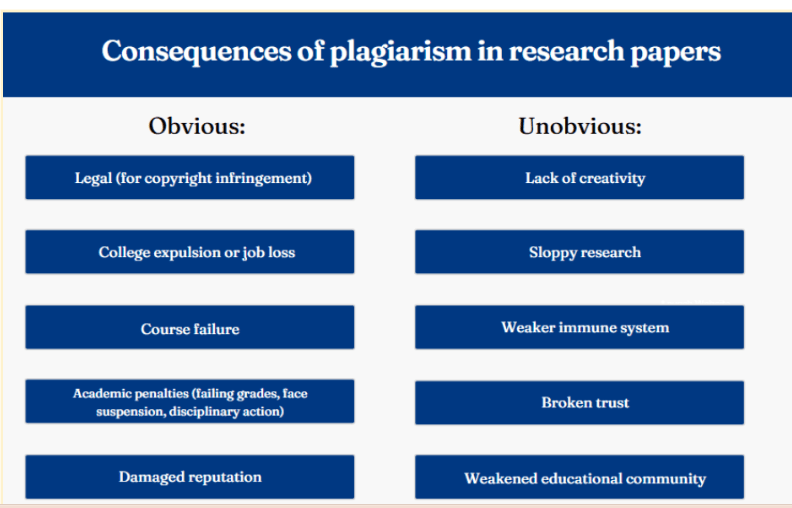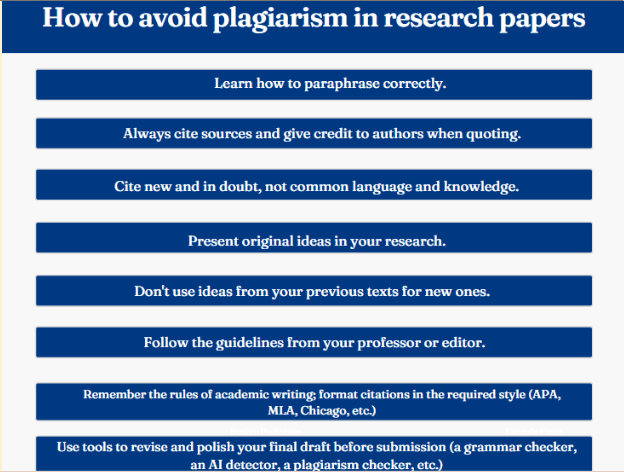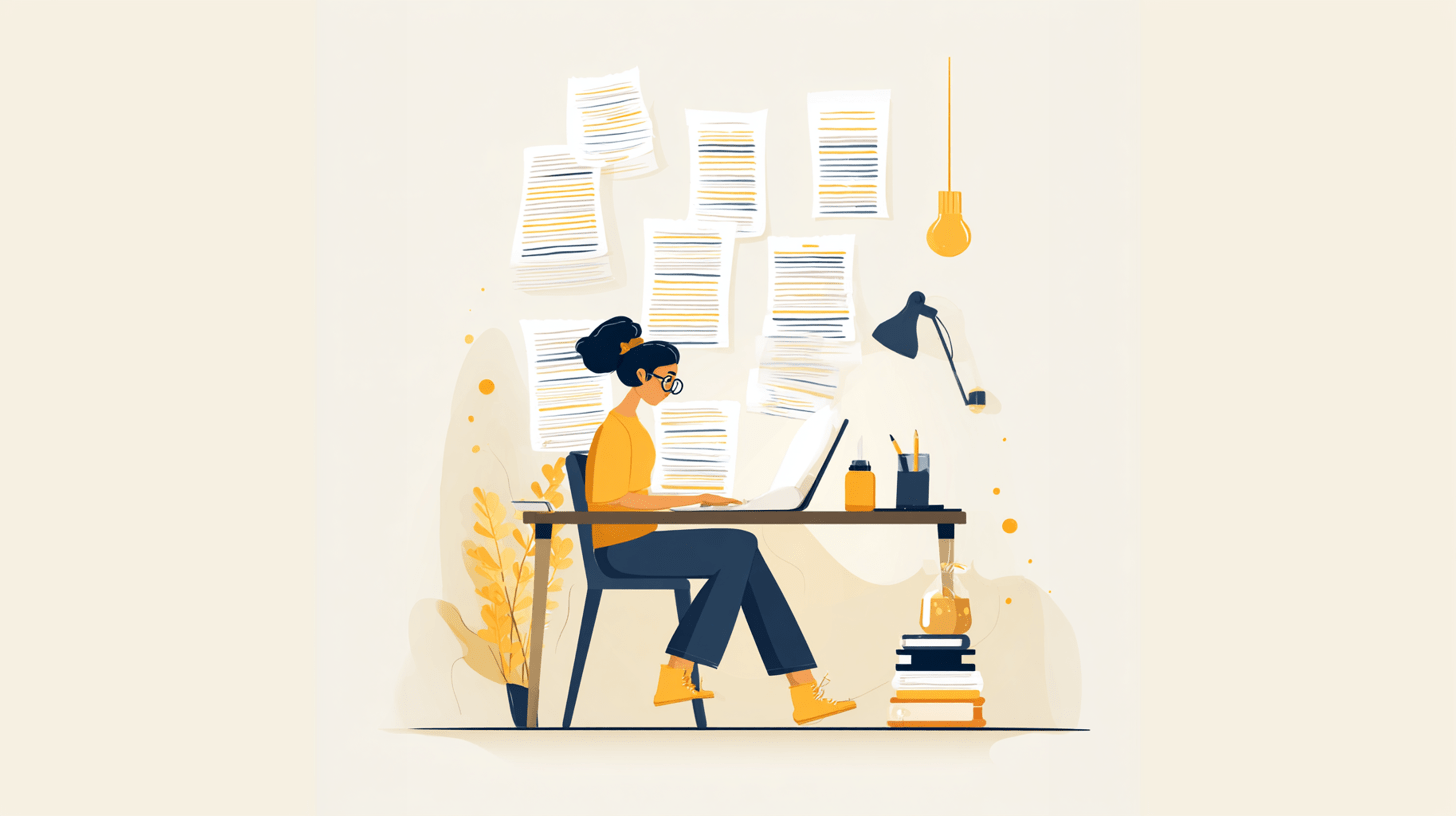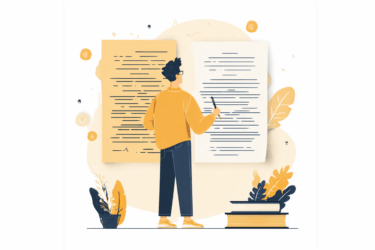In this article, you’ll learn the types and consequences of plagiarism in research papers and see how to avoid it in your work to maintain academic integrity and compliance with copyright.
In fact, the issue remains relevant and is becoming more complex and controversial, given the rise of AI technology. College students and aspiring researchers understand they need a reliable plagiarism tool to ensure the originality of their work, but most still don’t realize that the scale and peculiarities of plagiarism affect their academic performance and career.
Let’s see how to check for plagiarism in research papers and what you can do to prevent it in your scientific writing.
What is Plagiarism in Research Papers?
There are several definitions for plagiarism. In simple terms, it’s the use of someone else’s work or idea without citing the source.
When it comes to research papers and scientific writing in general, the most appropriate definition could be the one from the World Association of Medical Editors:
Plagiarism is “the use of others’ published and unpublished ideas or words (or other intellectual property) without attribution or permission, and presenting them as new and original rather than derived from an existing source.”
In the academic world, plagiarism involves two wrongs:
- Intellectual theft, i.e., when you use another person’s ideas or words without acknowledging their work.
- Fraud, i.e., when you pass off others’ ideas or words as your own to gain some advantage (a better grade, a reputation in academic communities, etc.).
Types of Plagiarism in Scientific Writing
When plagiarism in scientific writing happens, it may take different forms. The most common are these five.
- Direct (word-for-word) plagiarism. This one is the most serious form, which occurs when you copy and paste the whole text of someone else’s writing and present it as your own. It’s easy to identify, as you just cut and paste without credit.
- Mosaic (patchwork) plagiarism: When you can’t communicate an idea in your own words and use words or phrases from the source without citing. You “borrow” the formulations, mixing them (like a mosaic) and thus making them sound like yours.
- Paraphrasing (idea) plagiarism: You use different words to state someone else’s idea and present it as your own. For example, you take the ideas from the previously published articles of your colleagues or the assignments of your students while doing your research paper.
- Self-plagiarism. This form of plagiarism happens when you borrow some amount of work from your previously published articles. Say you take your single research paper and make several articles from it to increase your chances of publication in different journals. Or, you take a part of your previous research to paste into your new one.
- Incomplete citation plagiarism. In this form, plagiarism happens because your reference doesn’t match the source, or because you cite incomplete information from it. This often happens when you don’t know how to cite your source or what exactly to include in its citation.
Why does plagiarism in research papers take place, after all? If it’s unethical or even illegal, why, then, do students, academic writers, and researchers commit it?
The reasons vary, and plagiarists themselves communicate the following:
- Academic overload, a lack of time for writing assignments due to submission deadlines. (Poor time management skills are also here.)
- A lack of knowledge about the subject or academic writing standards. (They may not know how to cite courses, what to cite, etc.)
- Language/writing skills that are too poor to summarize, paraphrase, or synthesize the sources correctly.
- Social comparison and the pressure to succeed. (High expectations from the academic community based on the stereotype that one should perform well to succeed leads to stress and searches for alternative forms of “assistance.”)
- Laziness. (Yep, not that noble, but it has its place: some don’t have any interest in the subject a professor or college essay topic generator provides for their research, and they do it just because they “have to.”
Whatever your reason (if any), it can’t serve as an excuse for plagiarism. The consequences are harsh, and some aren’t as obvious to the plagiarist as they seem.
Consequences of Plagiarism in Research Papers

Is plagiarism more of a legal or ethical issue?
The short answer is, “Both.” Sometimes it’s a moral offence (simple dishonesty), but more often, it’s a serious problem leading to penalties or legal consequences for copyright infringement.
The wide range of ethical and legal issues that plagiarism brings determines the degree of the penalties inflicted. It can be a formal disciplinary action (refusal to provide a grant or publish your research paper, demand for an apology letter) or a criminal charge (suspension and prosecution).
While most consequences of plagiarism are obvious for students and academic institutions, they often forget or ignore the unobvious ones, which also affect a plagiarist.
For example, your immune system gets weaker because of the fear of getting caught and the stress of guilt. Also, you become less creative because you don’t challenge your brain to generate, explore, and defend original ideas. Plagiarism in research papers leads to a narrowing of academic debate, thus weakening the educational community in general.
When plagiarizing, you break the trust between you and your professor (editor), fostering feelings of suspicion and doubt. In the era of AI tools, not only do they rely on plagiarism checkers to scan your papers, but they also use AI detectors to ensure you don’t use text generators to craft your research. Tools like Chat GPT checker are now turning into a must-have to use before submitting your work for review, preventing the occurrence of AI text patterns in your research papers.
How to Avoid Plagiarism in Research Papers
Can you do anything while researching and writing your paper to prevent even accidental or non-intentional plagiarism? Below are the practices to add to your writing arsenal and answer the question of how to avoid plagiarism in research papers once and for all.
So, here we go.
What are the best practices for avoiding plagiarism in research papers?

(Source)
1. Cite Sources
It’s crucial to understand what you need and don’t need to cite in your research papers.
Cite:
- any words or ideas that are not yours but you took from other papers;
- your words from your other papers and publications (mind self-plagiarism).
For your research papers, use relevant and accurate sources. Cite all your references according to the required citation style (APA, MLA, or any other mentioned in the guidelines).
Don’t cite:
- facts and common knowledge (if in doubt, include a reference);
- the evidence you gathered while performing practical tests for your research.
2. Use Quotations
Learn when and how to quote to prevent direct or mosaic plagiarism in your papers. Using quotation marks to indicate the text you took from another paper, with a credit to the author, is a good practice to implement.
However, use quotes thoughtfully: placing a bunch of quotes from other researchers in your paper is not an option. Ensure you bring original ideas to your research; don’t simply write about the ideas of others. Engage the scientific community with original content. Chances are, your audience has already read the works of the other researchers you quote in your paper. They’ve come to your research to see something new, not a collection of quotes from others.
3. Paraphrase Like a Boss
It stands to reason that you won’t build your paper on entirely new ideas. You can borrow some from others while brainstorming or address others’ knowledge for inspiration or argumentation. That’s where smart paraphrasing can help you avoid unintentional plagiarism.
Don’t copy-paste others’ statements word-for-word; read the source carefully and restate the idea in your own words (how you understand it, without mixing the author’s formulations with poor synonymization to “cheat” plagiarism checkers).
Paraphrasing is about changing the syntax, not the meaning. When paraphrasing ideas for your research paper, ensure that you don’t use massive phrases from the source. Also, remember: even if you paraphrase, you need to give credit to the author. Use tools like Grade My Essay to evaluate the quality of your text and get suggestions for improvement.
4. Present Original Ideas in Your Research Papers
Your research should be about innovative ideas, not those previously published and borrowed from others.
Think of a unique perspective on your topic to contribute to the academic community. When you research and write from scratch, without trying to summarize or synthesize the findings of other researchers, the chances that you will unintentionally plagiarize something are lower.
Also, resist the temptation to reuse ideas from your previous assignments. (Self-plagiarism, remember?)
Maintain originality and use citations wherever necessary.
5. Follow the Guidelines
Check your institution’s policies: What do they say about plagiarism in research papers and the consequences it may bring? What do they consider plagiarism? Are there any guidelines they provide for authors on how to check for plagiarism in research papers (or how to avoid it)?
Follow the guidelines, always.
When writing for scientific journals, also read their guidelines for authors and make sure that you understand everything. By following the rules and academic standards, you’ll minimize the risk of plagiarism in your paper.
6. Never Copy-Paste When Writing
You take notes when researching, don’t you? It’s correct to maintain records of the sources and statements you’ll refer to in your paper, but it’s essential to structure and format those notes so they don’t violate copyright.
When incorporating your records and references in the draft, never copy-paste them the way you did during your pre-writing stage. You may not remember whether you paraphrased them or not, thus falling victim to accidental plagiarism as a result.
7. Use Advanced and Reliable Plagiarism Checkers
Don’t rush to submit your research paper for review once it’s ready. Use anti-pagiarism tools to check it and detect any accidental duplications or citation gaps.
Run your research paper through trustworthy tools to polish your text before final submission:
- a grammar checker will improve the quality, readability, and writing style;
- the aforementioned graders and AI detectors will ensure your work is authentic and meets the guidelines;
- a plagiarism checker will provide a detailed report with copied sections marked for revision to avoid accusations of plagiarism in your research papers.
How to Check for Plagiarism in Research Papers
A surefire way to check your paper for accidental plagiarism or duplication is to scan it with a reliable plagiarism checker tool. This software is trained to compare your submitted text against a massive database of sources and find content that’s identical or suspiciously similar.
How does it work? The algorithm is as follows.
- Document ingestion: The tool takes your text and splits it into analyzable units.
- Internal representation: The tool converts the text into a form that the system can compare quickly.
- Comparison: The tool checks the text’s fingerprints against databases (public web pages, academic journals, books, student submissions, and previous uploads to that service).
- Similarity detection (exact matches, paraphrase / semantic matches, citation and quotation detection).
- Scoring and highlighting a similarity percentage (+ a report with matched passages, source links, etc.)
Once you get a detailed report from your tool, here’s how to check plagiarism in research papers and interpret the report.
- First, look at the matched snippets side by side with the sources rather than relying on the overall percentage.
- Evaluate the context: the Methodology section of your research paper may be similar to others, as there are standard terms, methods, and techniques, but it will look more suspicious if your Analysis section is comparable to other sources.
- Then, check whether the matches are in your quotes or bibliography: Those are often acceptable.
And remember:
Similarity marked by a plagiarism checker is a flag, not a verdict. Human review is essential, so you may want to revise it by yourself or consult with a professional editor for the final proof.
Takeaways
That’s all, folks!
Now that you know the peculiarities of plagiarism in research papers and how to avoid and check for it in your writings, it’s time to put the information into practice and decide on the trustworthy tools you’ll use to scan your drafts for duplication.
Cite your sources, quote when using exact words, summarize while adding original analysis, and keep your notes to show your writing process if questioned. All these are actionable yet straightforward ways to prove your authorship and prevent accusations of plagiarism in your academic assignments.






